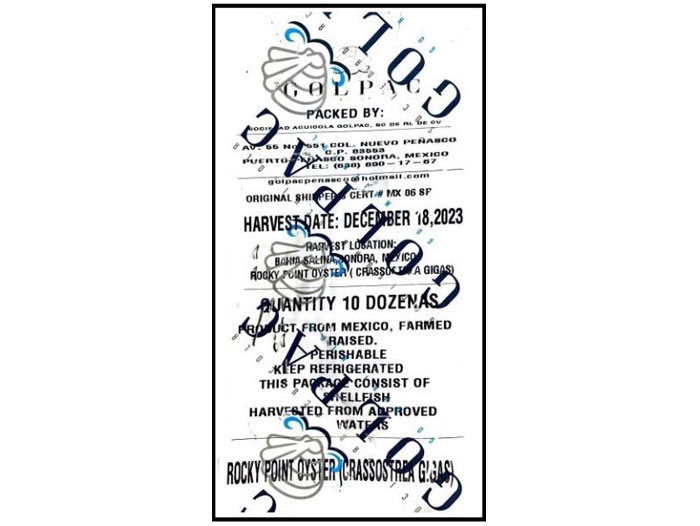FDA Advises Restaurants and Retailers Not to Serve or Sell and Consumers Not to Eat Certain Oysters from Bahia Salina in Sonora, Mexico Potentially Contaminated with Norovirus
January 16, 2024 | 4 min to read
The FDA has issued a warning regarding oysters from Sociedad Acuicola GolPac, harvested from Bahia Salina, Sonora, Mexico, on 12/18/2023 and 12/27/2023, due to potential norovirus contamination. Restaurants and retailers in California are advised to dispose of these oysters, while consumers should avoid eating them, as symptoms can lead to severe illness, especially in vulnerable populations. An ongoing investigation, initiated by the California Department of Public Health, is tracking related illnesses.

Audience
- Restaurants and food retailers in California that have recently purchased oysters from Sociedad Acuicola GolPac (MX 06 SP) harvested from Bahia Salina, Sonora, Mexico on 12/18/2023 or 12/27/2023.
- Consumers in California who have recently consumed oysters in San Diego or Los Angeles County, CA restaurants sourced from Sociedad Acuicola GolPac (MX 06 SP) harvested from Bahia Salina, Sonora, Mexico on 12/18/2023 or 12/27/2023.
Product
- Certain oysters from Sociedad Acuicola GolPac (MX 06 SP) harvested from Bahia Salina, Sonora, Mexico on 12/18/2023 or 12/27/2023. The oysters were distributed to restaurants and retailers in California and may have been distributed to other states as well.
Purpose
The FDA is advising restaurants and food retailers not to serve or sell and to dispose of oysters and consumers not to eat oysters from Sociedad Acuicola GolPac (MX 06 SP) harvested from Bahia Salina, Sonora, Mexico on 12/18/2023 or 12/27/2023 because they may be contaminated with norovirus.
Oysters contaminated with norovirus can cause illness if eaten raw, and potentially severe illness in people with compromised immune systems. Food containing norovirus may look, smell, and taste normal. Consumers of these products who are experiencing symptoms of illness should contact their healthcare provider and report their symptoms to their local Health Department. Diarrhea, abdominal cramps, nausea, vomiting, and fever may be associated with gastroenteritis infections caused by this organism.
Symptoms of Norovirus
People of all ages can get infected and sick with norovirus. The most common symptoms of norovirus are diarrhea, vomiting, nausea, and stomach pain. Other symptoms include fever, headache, and body ache.
A person usually develops symptoms 12 to 48 hours after being exposed to norovirus. Most people with norovirus illness get better within 1 to 3 days.
If you have norovirus illness, you can feel extremely ill, and vomit or have diarrhea many times a day. This can lead to dehydration, especially in young children, older adults, and people with other illnesses. Symptoms of dehydration include decrease in urination, dry mouth and throat, and feeling dizzy when standing up. Children who are dehydrated may cry with few or no tears and be unusually sleepy or fussy.
If you think you or someone you are caring for is severely dehydrated, call your healthcare provider.
Summary of Problem and Scope
On 1/10/2024, the California Department of Public Health notified the FDA of an outbreak of Norovirus in San Diego County, CA that has been linked to consumption of oysters tracing back to a specific harvest location in Mexico. An investigation is ongoing and the number of illnesses is being tracked.
Mexican Shellfish Authorities have initiated an investigation into the source of the illnesses and have closed the Bahia Salina growing area to harvest on 1/12/2024.
FDA Actions
The FDA is issuing this alert advising restaurants and food retailers not to serve or sell and consumers not to eat oysters from Sociedad Acuicola GolPac (MX 06 SP) harvested from Bahia Salina, Sonora, Mexico on 12/18/2023 or 12/27/2023 due to norovirus contamination. The FDA is awaiting further information on distribution of the oysters harvested and will continue to monitor the investigation and provide assistance to state authorities as needed. As new information becomes available, the FDA will update the safety alert.
Recommendations for Restaurants and Retailers
Restaurants and retailers should not serve or sell the potentially contaminated oysters. Restaurants and retailers should dispose of any products by throwing them in the garbage or returning them to their distributor for destruction.
Restaurants and retailers should also be aware that shellfish may be a source of pathogens and should control the potential for cross-contamination of food processing equipment and the food processing environment. They should follow the steps below:
- Wash hands with warm water and soap following the cleaning and sanitation process.
- Retailers, restaurants, and other food service operators who have processed and packaged any potentially contaminated products need to be concerned about cross-contamination of cutting surfaces and utensils through contact with the potentially contaminated products.
- Retailers that have sold bulk product should clean and sanitize the containers used to hold the product.
- Regular frequent cleaning and sanitizing of food contact surfaces and utensils used in food preparation may help to minimize the likelihood of cross-contamination.
Recommendations for Consumers
Consumers should not eat the potentially contaminated oysters. Consumers who have symptoms should contact their health care provider to report their symptoms and receive care.
